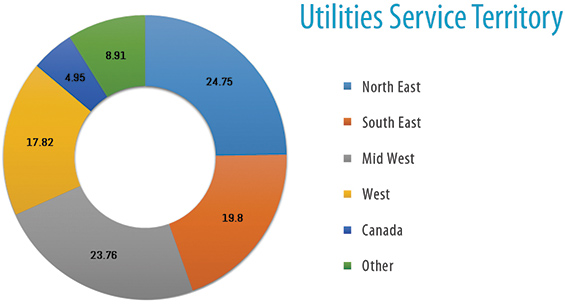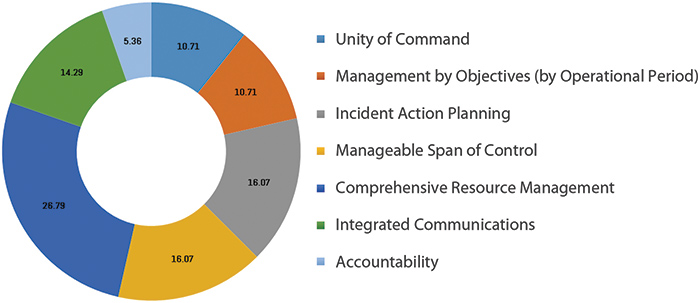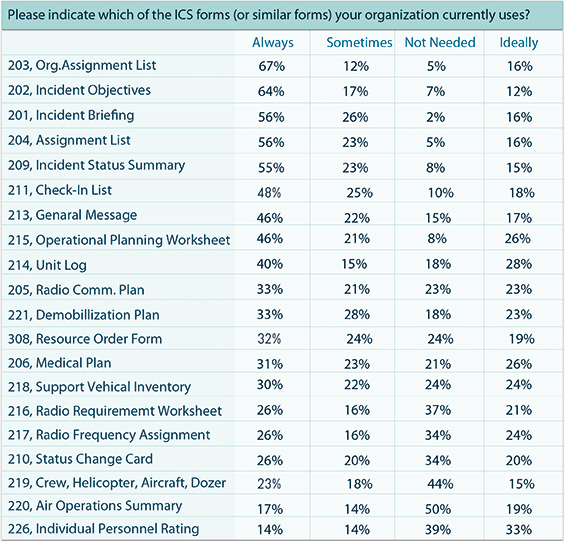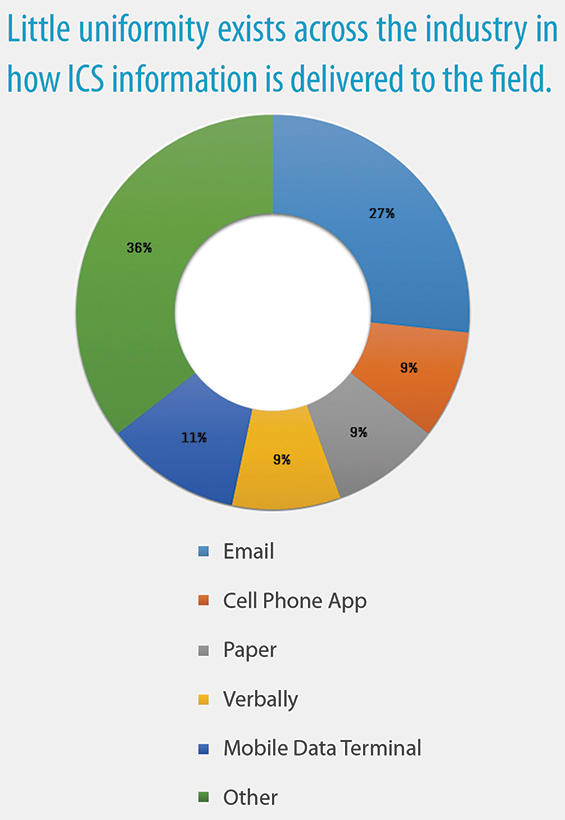To improve emergency response operations, utilities across the United States and Canada are increasingly adopting the Incident Command System (ICS). Given what appears to be the increasing severity of weather, the greater number of incidents that result, and instant visibility into events in a wired world, it is no surprise that ICS is gaining in prominence in the utilities industry. Most importantly, ICS is likely to gain even wider adoption because it is a proven approach to coordinated, cost-effective incident management.
To identify trends, best practices, and challenges of ICS in the utilities industry, Macrosoft, Inc. conducted an online survey during August 2013. It encompassed 85 participants, representing investor-owned as well as municipal utilities, drawn for every region of the U.S. (see Figure 1, with customer bases that range from fewer than 100,000 customers to more than three million.

Figure 1
Survey results present a decidedly mixed picture. While much progress has been made, significant obstacles remain. For example, companies are expected to implement ICS but they fail to budget for it, yet this relatively small investment could help them avoid the enormous costs of sub-optimal incident response year after year. Many respondents indicate that during an incident they lack adequate communication with the field or with people they don’t normally work with, pointing up the need for systems that provide fast and effective communication both internally and externally. As with communication, many companies appear to need a technology solution to help guide them through the ICS process. But obstacles can also be opportunities, as the survey results indicate in four critical elements of ICS: adoption, training, execution, and tools and technology.
ICS Adoption
Ninety-five percent of survey respondents see ICS as ‘important’ or ‘very important’ for effective emergency response. About half use ICS every time an incident occurs, followed by a little less than 30 percent who report using ICS ‘sometimes’ when incidents occur, and 20 percent who are not using it but feel they should.
Asked how they currently implement ICS when an incident occurs, almost half (47%) said they follow the National Incident Management System (NIMS) guidelines, the national blueprint for effective and efficient incident management. But they say also that they customize the guidelines for utility company use. Fourteen percent of respondents use some, but not all, of the guidelines, while 25 percent primarily use their own management system, and 14 percent use none of the guidelines.
Although several respondents said that there is little that is unique about utilities that hinders adoption of ICS, far more cited distinctive industry characteristics. Most utilities, for example, are regionally focused, as opposed to entities that are municipally or nationally focused. Further, utilities work by circuit. An outage in one municipality may require work in another community, a dynamic that local governments sometimes do not understand. Utilities can also be extremely hazardous, requiring a difficult balance between ‘make safe’ and ‘restore.’ In addition, utilities have obligations to certain regulators, agencies, and investors; and although senior management is responsible for operations, during an incident many agencies suddenly feel that the utilities report to them.
The overwhelming agreement about the importance of ICS could eventually mean a ground swell of support within the utility industry for the adoption of the ICS process and the establishing of appropriate forms and tools. At the very least, such agreement suggests that utilities not currently using ICS should begin investigating how it might benefit them to adopt it.
ICS and the Utilities
We are in conversation with Ann Steeves, MCP, MBCP, Operations Manager with Portland General Electric (PGE) about the advantages of a utility adopting the Incident Command System (ICS).
EET&D: Can you provide me with the demographics of the utility?
Steeves: PGE’s service territory covers urban (Portland Metro) and rural areas in a seven county area. The company serves almost 900,000 customers (residential, business, and industrial/commercial).
EET&D: Are there unique challenges (geography, prevailing weather, etc.) faced in serving your customer base? In that vein, are utilities bound to move up from analog to two-way digital communications systems to ensure more accurate and wider coverage of their service territories when reaching field crews?
Steeves: Oregon is on the Pacific Ring of Fire which hosts a very diverse landscape including the risk of the Cascadia Subduction Zone earthquake/tsunami (predicted to be 9.0 shaking for up to four minutes followed 20 minutes later by a tsunami along our coast); Pacific Storms (they don’t call them hurricanes out here) and Winter Storms with snow and ice. PGE is strengthening its current communications capabilities to reach crews in any number of locations.
EET&D: Is ICS mandated in your state?
Steeves: ICS is not mandated in Oregon but strongly encouraged and widely adopted. Some of the best trainers in the country hail from Oregon (those who serve on Type 1 Incident Management Teams (IMTs).
EET&D: Has there been an incident where the ICS has ‘saved your skin’ or that of your customers?
Steeves: Staffs that are trained and use ICS frequently; it is always ‘on’ and follow a planned, trained process of escalation. If you plan, train and exercise well, ICS becomes one of the tools in your toolkit.
EET&D: Are the implementation and standard features of ICS user-friendly – how easy would it be to sell to a nay-sayer, for example?
Steeves: Initially, ICS is not easily understood and requires a paradigm shift or culture change. Those implementing the system have to first understand the utility, how it responds, and adapt a cadence for ICS implementation that will make it adoptable. Today, ICS as offered at the national/federal level is NOT utility friendly. The Western Energy Institute (WEI) out west is working with all of the interested utilities to take ICS to the next level.
EET&D: Do you have an ICS training program in place?
Steeves: PGE has an ICS training program in place and is focused on three levels:
- Corporate Incident Management Team
- Facility based Incident Management Teams to handle local incidents
- ICS in the Field – PGE Personnel arriving on scene with Law Enforcement or Fire
EET&D: From strictly the T&D side, taking into account individual inherent bureaucratic differences, who in your estimation is more likely to accept and implement the program – where costs, standardization, training, etc. are all taken into account Munis, IOUs, ISOs, Co-ops?
Steeves: Part of this equation is making ICS valuable and affordable. The materials currently available at the national/federal level have not been tailored to utilities. The industry still needs to approach this work in order for utilities to see the benefit of ICS. One other topic of discussion is ‘to certify or not to certify’– this is a rather expensive proposition in terms of FEMA seat time requirements – reinventing the wheel would be more costly. The industry will need to decide.
The more utilities gain in terms of ICS the more likely they will be to utilize a system that has been implemented in a variety of other disciplines with demonstration of its value and the more interoperable utilities will become when they have to support one another through mutual assistance in times of need.
EET&D: We can’t thank you enough Ann for taking the time out of what must be a crazy schedule to let our readers in on some of the important details surrounding ICS in general and how it fits in with PGE’s mandate.
About the Author
 Ann Steeves is the Operations Manager for Business Continuity Emergency Management (BCEM) at PGE.
Ann Steeves is the Operations Manager for Business Continuity Emergency Management (BCEM) at PGE.
The Challenges of Training
From the survey, the challenges of training emerged as a recurrent theme. For example, while the adoption of standard guidelines may be accelerating, the availability of training to the industry appears to be insufficient. The training that the Federal Emergency Management Agency (FEMA) offers remains focused on the community-based first responders – utilities may therefore find it difficult to adopt materials and exercises that are not applicable to utility-response. In addition, some respondents observed that it is difficult to find the time to train an already busy workforce on a second set of responsibilities
How companies train on ICS varies widely:
- 40 percent follow the national guidelines
- 29 percent use in-house, non-FEMA training only
- 23 percent use FEMA online training and in-house training
- 8 percent use FEMA online training only.
As these results indicate, a great deal of in-house, non-FEMA training is currently taking place, but when non-FEMA training is conducted by utilities, industry experts say, it tends to be about ‘organizational incident management’ rather than ICS.
Frequency of training also varies widely. Fifty percent of companies train on ICS annually, about 10 percent train quarterly, and among those who responded ‘other’ several say they train monthly. In addition, a few companies train based on employee turnover or whenever there is a corporate mandate to train.
Regular formal training remains a critical success factor for all ICS functions, no matter how the training is conducted. During an incident, procedures must be followed out of deeply ingrained habit – there is no time to open old training guides. Given this imperative, job aids and just-in-time computer-based training can be a great help. Yet utility companies have not yet automated, standardized and made scalable the processes for its use, some of which disparity may be attributable to the lack of materials suitable for the industry.
Execution: ICS in Action
A number of companies indicated that for them ICS is ‘always on.’ For the other respondents, the trigger points for activating ICS fall into three distinct groups:
- Size of the incident
- Number of outages
- When someone either internally or externally declares that it is time to use it.
Asked which critical success factor is the biggest challenge during an incident, almost 27 percent selected ‘comprehensive resource management’ (see Figure 2). ‘Action planning’ and ‘manageable span of control’ were each cited by 16percent of respondents as the biggest executional challenge of ICS.

Figure 2
(click to enlarge)
ICS specifies that any single person’s span of control should be between three and seven individuals. If more than seven resources are being managed by an individual, then that person is being overloaded. To avoid overload, ICS expands the command structure by delegating responsibilities, which can empower otherwise junior employees to make decisions that exceed the authority of their day-to-day jobs. Asked whether junior employees are given greater authority when ICS is activated:
- 56% said ‘sometimes,’
- 20% who said ‘always,’
- 13% who said ‘never’
- 12% who said ‘ideally, but not currently’
Further, said some respondents, even though their companies have adopted ICS and train on it personnel often revert to their normal day-to-day way of doing things when an incident occurs.
ICS and the Utilities
With a different take on the Incident Command System, EET&D is speaking with Joseph (Joe) M. Golden, Jr., EMT-P, CHMM, CEM, CBCP, MEP. Joe is a Critical Infrastructure Protection consultant.
EET&D: Please give us an idea of where your job as consultant has taken you?
Golden: I’ve worked with utilities in the Northeast, South/Gulf Coast, Texas, and California.
EET&D: Was there any incident in particular that you would consider to be a ‘wake-up call?’
Golden: For the Northeast it was definitely hurricanes Irene and Sandy. For the South, I would have to say the horrific April 25–28, 2011 tornado outbreak. The Gulf Coast and Texas when they were hammered by Katrina, Rita, and Ike.
EET&D: Is ICS generally mandated?
Golden: I’ve worked with utilities in states that required ICS and others that don’t.
EET&D: Has there been an incident where the ICS has ‘saved your skin’ or that of your customers?
Golden: One utility told me that learning and practicing ICS allowed them to ‘eat an elephant one bite at a time’… that is, ICS principles (e.g., management by objectives, incident action plan, span of control) allowed them to tackle a comprehensive recovery effort that would have seem overwhelming before.
EET&D: Are the implementation and standard features of ICS user-friendly – how easy would it be to sell to a nay-sayer, for example?
Golden: The key is to customize training on ICS to the utility. Utility management and staff do not see the benefits of ICS while training using wildfire and non-utility disaster scenarios. Once the concepts and principles of ICS are applied to a utility in training, the benefits become clearer and practice does become user friendly.
EET&D: Do you have an ICS training program in place?
Golden: Most of my work with utilities started with creating and implementing their ICS training program.
EET&D: From strictly the T&D side, taking into account individual inherent bureaucratic differences, who in your estimation is more likely to accept and implement the program – where costs, standardization, training, etc. are all taken into account Munis, IOUs, ISOs, Co-ops?
Golden: The issue is culture change – the need to transitioning from a reactive approach to proactive approach. Looking at what you’re doing today, planning on what you can do tomorrow with the resources at hand, and implementing the plan tomorrow.
EET&D: Joe, on behalf of the magazine, I would like to thank you for your insights as a consultant in this key area. We appreciate your time from an obviously ubiquitous and hectic schedule.
About the Author
 Joseph (Joe) M. Golden, Jr., EMT-P, CHMM. CEM, CBCP, MEP has been working with utilities and critical infrastructure for 20 years in improving their preparedness, incident management, and response capabilities.
Joseph (Joe) M. Golden, Jr., EMT-P, CHMM. CEM, CBCP, MEP has been working with utilities and critical infrastructure for 20 years in improving their preparedness, incident management, and response capabilities.
As the issues of resource management and span of control suggest, ICS is a management system, not merely a communication system, yet 30 percent of respondents say that when their companies activate ICS it is used only for communication. While the 70 percent who said that their companies use ICS as a management system, is an overwhelming majority, it is sobering to reflect that as many as three in ten companies do not leverage the intended purpose of the system.
One of the great advantages of the system is its ability to scale. Eighty-six percent of companies that use ICS expand and contract it according to the nature of the incident. Surprisingly, however, less than 30 percent of companies always begin preparing for demobilization on day one of an incident and 40 percent never do. Huge cost overruns can be incurred if demobilization is not planned early, resulting, for example, in a parade of bucket trucks all restoring power to the last home. By contrast, effective ICS demobilizes crews once there is a schedule for remedying all disruptions to the system.
Enablers: Tools and Technology
Fifty-six percent of companies have modified ‘standard’ ICS forms and tools to match their requirements. That’s not surprising, since those forms were not designed for electric power companies in the first place, but widespread modification of forms will result in multiple versions of ICS across the industry. However, there are 14 forms that are used either always or sometimes by at least half of utility companies and might provide the starting point for standardization across the industry (see Figure 3).

Figure 3
(click to enlarge)
A large number of survey participants cited automated systems as a key enabler of an improved ICS process. They also identified the critical requirements of such a system: ease-of-use, ample reporting for senior management, ability to communicate with existing systems, real-time situational awareness, and uniformity across multiple utilities. However, as the survey results indicate, automated systems and uniformity across the industry have a long way to go. In fact, almost two-thirds of companies use ICS solutions that are either paper-based or homegrown.
In addition to the 66 percent of respondents who are using a paper-based or homegrown system, a number who responded ‘other’ identified their systems as a mix of the two. In answer to a related question, 56 percent of respondents indicated that their companies have no software application supporting their ICS process.
These results are worrisome in that paper-based tools are slow and lack search and reporting capability while home-grown tools lack consistency across the industry and are subject to neglect.
Companies also use a wide variety of means to deliver information to the field (see Figure 4). While 37 percent of companies deliver information to the field via email or mobile data terminals, 27 percent do so verbally or via paper. Further, those who responded ‘other’ indicated that they use wide variety of combined communication methods, which may include email, text, cell phone, verbal, and paper. While the use of multiple methods is understandable, the question arises as to whether these combinations of methods are used in a consistent fashion or are merely ad hoc, allowing personnel to use whatever is convenient rather than what is best for the situation and the company.

Figure 4
The Way Forward?
The adoption and implementation of ICS, as with any comprehensive system intended to manage highly complex phenomena, will inevitably encounter obstacles. But those shortcomings – the lack of uniformity, standardization, and automation in ICS adoption, training, execution, and tools – also suggest some concrete steps the industry could take to overcome them.
For example, companies could begin by sharing the ways in which they have modified and customized the most widely used ICS forms. They could then identify best practices and create industry-wide standard forms – preferably ‘smart’ forms that can be passed from shift to shift on a common platform. A widely adopted software application or automated guide to ICS could also significantly help provide a higher level of uniformity, efficiency, and effectiveness than ad hoc and homegrown approaches. The emergence of an automated, industry-wide system could be facilitated by the creation of a standards-body to ensure to ensure uniformity. In addition, utility companies may want to consider further combining their efforts in a development and training institute that might be something like FEMA’s Emergency Management Institute. In any case, industry experts observe that the more standardization and commonalities both within the industry and across entities that interface then the more effective ICS will be, benefitting everyone: customers, companies, and the communities they serve.
About the Author
 John Kullmann is Vice President of Marketing and Sales at Macrosoft, a New Jersey Technology company. With more than twenty years experience, John is a recognized expert in business development efforts for professional services firms. He is responsible for expanding Macrosoft from its traditional roots as a leading software development and system implementation company into an equally accomplished provider of packaged technology products.
John Kullmann is Vice President of Marketing and Sales at Macrosoft, a New Jersey Technology company. With more than twenty years experience, John is a recognized expert in business development efforts for professional services firms. He is responsible for expanding Macrosoft from its traditional roots as a leading software development and system implementation company into an equally accomplished provider of packaged technology products.








